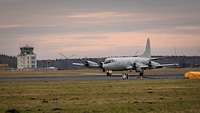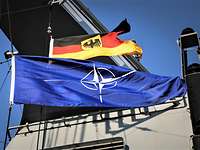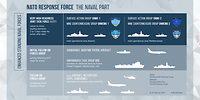
Fleet Commander: “German Navy shows alliance solidarity”
Since 1 February, the Navy has been stepping up activities on NATONorth Atlantic Treaty Organization’s northern flank. A tangible expression of solidarity with allies.


With four multinational, integrated naval formations, NATONorth Atlantic Treaty Organization is prepared for conflict at sea. Germany is contributing to all of them.

In addition to military operations mandated by the Bundestag, the German Navy is constantly involved in the four multinational naval formations of NATONorth Atlantic Treaty Organization. Such so-called “anerkannte Missionen”, literally recognized missions, are part of Germany’s commitments to the North Atlantic Alliance, even in times of peace. The Navy permanently detaches vessels to those joint maritime forces.
In practice, these deployments are only partially similar to the mandated operations, including, for example, the participating servicewomen and men being away from home for several months. Probably the most important differences to current operations are: firstly that the NATONorth Atlantic Treaty Organization naval formations have existed for decades, and secondly they are only very roughly limited to specific regions.
The latter is one of the reasons why they are quickly available maritime reaction forces, which the alliance can use flexibly in the event of any crises or conflicts. The four naval task groups therefore belong to the NATONorth Atlantic Treaty Organization Response Force; and within this formation they are the maritime part of the Very High Readiness Joint Task Force (VJTFVery High Readiness Joint Task Force ) – NATONorth Atlantic Treaty Organization’s permanently operational spearhead.
NATONorth Atlantic Treaty Organization’s Standing Naval Forces are subordinate to the Allied Maritime Command (MARCOMAllied Maritime Command), with its permanent headquarters in Northwood near London. They are directly led by a naval commander on-board a flagship rotated annually among NATONorth Atlantic Treaty Organization partners. The participating vessels also change regularly.
The two Standing NATONorth Atlantic Treaty Organization Maritime Groups, SNMGStanding NATO Maritime Group 1 and SNMGStanding NATO Maritime Group 2 for short, usually consist of several destroyers and frigates as well as a supply ship from the fleets of almost all NATONorth Atlantic Treaty Organization member states – including a ship from Germany. With these naval vessels, the main capabilities of the formations are above all control and protection of strategically important sea routes.
In peacetime, SNMGStanding NATO Maritime Group 1 operates primarily in the North Atlantic, North Sea and Baltic Sea, but can immediately move to other crisis areas if necessary. This Maritime Group is the oldest in NATONorth Atlantic Treaty Organization, founded in 1967 as “Standing Naval Force Atlantic”. In 2005 it received its current designation.
SNMGStanding NATO Maritime Group 2 usually operates in the Mediterranean, but may also head for other sea areas immediately if necessary. The formation was formed in 1992 as “Standing Naval Force Mediterranean”; in 2005 it was renamed SNMGStanding NATO Maritime Group 2.
The two Standing NATONorth Atlantic Treaty Organization Mine Countermeasures Groups, abbreviated to SNMCMGStanding NATO Mine Countermeasures Group 1 and SNMCMGStanding NATO Mine Countermeasures Group 2, usually are made up of several mine countermeasures vessels and a command and supply ship from various NATONorth Atlantic Treaty Organization partners – one of which is always provided by Germany. Both formations are designated to detect and destroy sea mines. This also includes removing ammunition from past wars and conflicts.
SNMCMGStanding NATO Mine Countermeasures Group 1 operates in Northern European waters, especially in the English Channel, in the North Sea and the Baltic Sea. If required, it can also deploy to other regions. This naval formation was established in 1973 as “Standing Naval Force Channel”; in 2005 it was renamed SNMCMGStanding NATO Mine Countermeasures Group 1.
The regional focus of SNMCMGStanding NATO Mine Countermeasures Group 2 is the Mediterranean. However, it can also operate in other sea areas. This youngest NATONorth Atlantic Treaty Organization naval task group was activated in 1999. It received its current designation SNMCMGStanding NATO Mine Countermeasures Group 2 in 2005.
Above all, their spatial flexibility makes the Standing Naval Forces ideal maritime response forces, which are available to the Alliance relatively quickly in the event of possible crises or conflicts. The four permanent naval formations are therefore part of the NATONorth Atlantic Treaty Organization Response Force (NRFNATO Response Force) or, more precisely, the Very High Readiness Joint Task Force (VJTFVery High Readiness Joint Task Force ). This multinational force stands ready to react to a crisis almost immediately. Its naval components, the four NATONorth Atlantic Treaty Organization naval task groups, are thus also permanently ready for action.

Like its partners, the German Navy deploys to NATONorth Atlantic Treaty Organization’s maritime forces only vessels and crews that are fully equipped and trained. In order to keep this operational readiness at a high level, the Maritime Groups take part in various national and international exercises.
This continuous training is just as much part of the formations’ tasks as military deterrence. If necessary, they provide embargo controls, search and rescue operations as well as humanitarian emergency and disaster relief.
Last but not least, ships and their crews serve as ambassadors in blue: NATONorth Atlantic Treaty Organization’s Standing Naval Forces regularly visit various ports in allied or friendly countries, representing their navies and nations abroad.